10 Best Email Newsletter Software (2024 Comparison)
Looking for the best email newsletter software? You’re in the right place.
In this post, we’ll be reviewing and comparing all the best email newsletter tools on the market this year.
All these platforms come with everything you need to craft beautiful email newsletters, manage your mailing list, and set up automated campaigns.
But to help you figure out which one is the best fit for your needs, we’ve highlighted the pros and cons, key features, and pricing of each.
The best email newsletter software – comparison
Top Picks:
- MailerLite – Best overall. Industry-leading email deliverability, easy-to-use, and affordable.
- Moosend – Best for ease of use.
- Brevo – Best for low-volume senders.
- ConvertKit – Best for content creators.
- ActiveCampaign – Best for automation.
#1 – MailerLite
MailerLite is our overall favorite email newsletter software thanks to its excellent feature set, easy-to-use interface, and best-in-class deliverability.
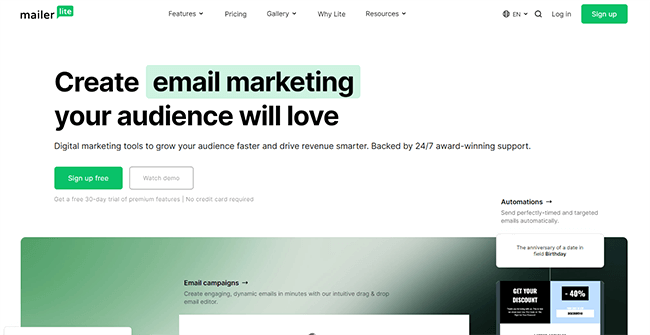
With MailerLite, you get all the tools you need to craft beautiful, engaging newsletters, and manage your email marketing campaigns.
There are three different newsletter editors to choose from: a drag-and-drop editor, a rich text editor, and an HTML editor.
The drag-and-drop version is incredibly easy to use: You just select a block, drag it into position, and then edit it to fill out the email with content.
It’s AI-enhanced too, so if you don’t want to write the content yourself, you can let MailerLite’s artificial intelligence fill in the blanks for you.
Newsletters can be personalized for different recipients/segments with dynamic content and custom fields, and you can add interactive elements like social share blocks, surveys, e-commerce blocks, and RSS blocks.
And newsletters are just the start. MailerLite also comes with a bunch of other powerful features, including email marketing tools, automations, landing pages, sign-up forms, an email verifier, and even a complete blog and website builder.
It’s also e-commerce-ready, so you can take payments and sell things like ebooks, digital downloads, and paid newsletter subscriptions.
Key features
- Newsletter editor
- AI email generator
- Templates
- Image library
- Automation
- RSS campaigns
- Segmentation
- Personalization
- Landing pages
- Signup forms
- Subscriber management
- Click maps
- A/B testing
- Reporting
- Website builder
- Digital products
Pros
- Broad feature set
- Easy to use
- Excellent deliverability
- Great templates
Cons
- Only basic ecommerce features
- Would benefit from some extra templates
Pricing
Free plan available. Paid plans start from $10/month, save 10% when you pay yearly.
Read our MailerLite review.
#2 – Moosend
Moosend is our runner-up pick. It’s the easiest email marketing and automation platform on the market, so it’s a good choice for users who want to keep things simple.
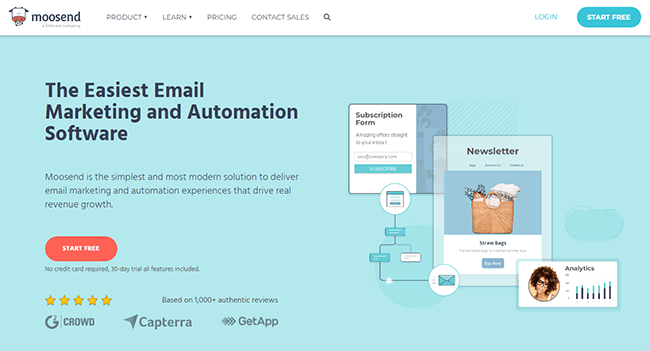
Moosend’s drag-and-drop newsletter editor is a breeze to work with. It comes with lots of great templates and pre-built email blocks to save you time and effort.
There are also a few features to help you optimize your newsletters to get more opens, clicks, and conversions, including an AI subject line optimizer, and an A/B testing tool that lets you compare different versions of your subject lines and content.
Aside from newsletters, you can also use Moosend to create landing pages and subscription forms to grow your list.
Plus, manage your subscribers with CRM and segmentation tools, and set up automated campaigns with a visual workflow builder and a bunch of prebuilt automation templates.
You can track the performance of your email marketing campaigns with rich, easy-to-understand reports and analytics.
Another feature we like about Moosend is its ecommerce AI and product recommendation engine.
You can create fantastic shoppable emails with product blocks and buy buttons, and automatically tailor product recommendations to different users based on factors like their activity, lookalike customers, purchase history, etc.
All Moosend plans include unlimited emails, and prices depend on the number of subscribers. If you have a small email list, it’s super affordable.
Key features
- Email campaigns
- Email newsletter builder
- Templates
- Product recommendations
- Automation workflow designer
- Site tracking
- Analytics & reporting
- A/B testing
- Heatmaps
- Transactional email
- Sign up forms
- Landing pages
- 100+ integrations.
Pros
- Unlimited emails on all plans
- Very easy to use
- Great value for money
- Good personalization features
- Good for teams & agencies
Cons
- Not as many third-party integrations as other platforms
- A/B testing could be better
Pricing
Plans start from $9/month, discounts are available when you pay annually. Get started with a 30-day free trial.
Read our Moosend review.
#3 – Brevo
Brevo is an all-in-one CRM suite with email marketing functionality. It’s the best choice for low-volume senders due to its send-based pricing model.
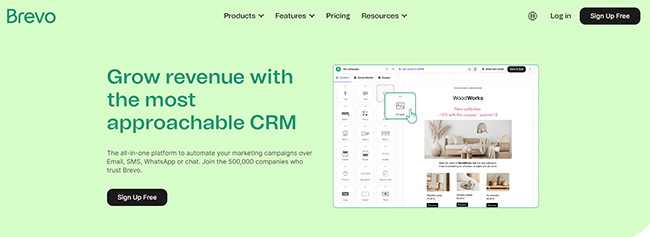
Brevo is one of the few platforms that offers unlimited subscribers on all plans. So unlike the other email newsletter tools we’ve looked at so far, you won’t pay more if you have a large list.
Instead, pricing is based on the number of emails you send every month. So if you have a lot of contacts, but you only send a low volume of monthly emails, it’s a very economical choice.
It’s also super feature-rich. You get all of the email tools you’d expect, like pre-made templates, a drag-and-drop email editor, automations, contact management, etc.
However, on top of that, you also get lots of other tools to help with other areas of your marketing and sales campaigns. That includes SMS and WhatsApp campaigns, live chat tools, meetings scheduler, deal pipelines, ecommerce features, and more.
Because there are so many features, Brevo is split into different ‘products’, each of which includes different tools. The Marketing Platform includes all the email features (templates, drag and drop editor, transactional emails), as well as SMS & WhatsApp campaigns.
But if you want access to the sales tools, you’ll need to subscribe to the Sales Platform separately. And for the chatbot/live chat tools, you’ll need to subscribe to the Conversations plan.
Key features
- Email campaigns
- Drag and drop editor
- Template gallery
- SMS marketing
- Personalization
- WhatsApp campaigns
- Shared inbox
- Transactional email
- Automation
- Page tracking
- Contact management
- Segmentation
- Signup forms
- Push notifications
- Reporting
- Live chat/chatbot
- Phone
- Inbox
- Deal pipelines
- Meetings
Pros
- Unlimited subscribers/contacts on all plans (including free)
- Good sales features
- Very feature-rich
- Straightforward UI
- Excellent deliverability
Cons
- Higher starting price than some platforms
- Bit of a learning curve
Pricing
A free plan is available. Paid plans start from $25/month, get 10% off when you pay yearly
Read our Brevo review.
#4 – ConvertKit
ConvertKit is the best choice for creators. It’s advertised as a ‘creator marketing platform’ and comes with lots of powerful email, lead generation, and automation tools.
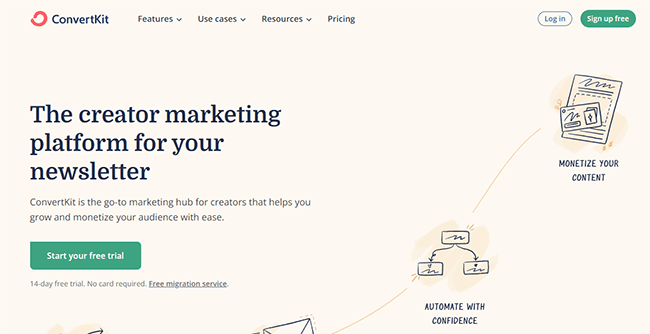
ConvertKit has been built specifically for creators (i.e. authors, coaches, musicians, podcasters, etc.), rather than businesses. So as you’d expect, it’s very easy to use, with an intuitive interface and lots of great creator-focused templates.
You can use ConvertKit to build high-converting landing pages and opt-in forms that grow your list. Then, use the email designer to create and deliver beautiful newsletters to your audience.
Filters make it easy to segment your audience and send out targeted campaigns, and you can automate your marketing efforts with the visual workflow and funnel builder.
ConvertKit also comes with a few unique features that we haven’t seen on any other email marketing platform.
The first is the Creator Network, which provides a neat way to grow your newsletter audience with little to no effort.
All you have to do is sign up and recommend other creators with a similar audience to you to your existing audience. You’ll then be added to the directory, where other creators can find and recommend you to their audience. It’s a win-win situation where creators cross-promote each other in order to grow together.
The Sponsor Network is another cool feature that makes it easy for creators to earn money from their newsletter. Once you sign up, ConvertKit will connect you with premium advertisers and place sponsorships in your newsletters, so you can start earning advertising revenue.
ConvertKit also excels when it comes to deliverability. They boast a superb average delivery rate of 99.73%, so you can be sure your emails stand the best chance of reaching your contacts’ inboxes.
Key features
- Email designer
- Automations
- Contact management
- Email templates
- Creator network
- Creator profile
- Personalization
- Landing pages
- Forms
- Sell digital products
Pros
- Great for creators
- Some unique features
- Easy to use
- Affordable
- Excellent deliverability
Cons
- Reporting could be better
- No spam testing
- Email editor and templating system isn’t as flexible as other tools
Pricing
Free plan available. Paid plans start at $15/month, get 2 months free when you pay yearly.
Read our ConvertKit review.
#5 – ActiveCampaign
ActiveCampaign is another great marketing and sales platform with email newsletter features. It comes with all the tools you need to create fantastic customer experiences and some of the best automation features.
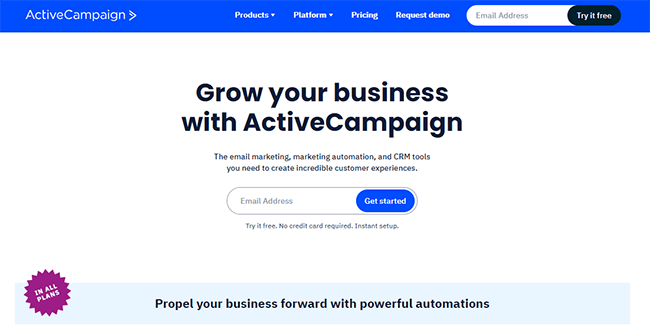
You can build emails in ActiveCampaign’s drag-and-drop email designer in minutes. Then, schedule them to be sent out as one-time broadcasts at a specific date/time, or set them up as triggered emails to be sent out based on customer actions (purchases, site visits, engagements, etc.).
To improve the performance of your newsletters, you can use ActiveCampaign’s contact management tools to group your audience into segments. Then, send targeted emails to each group, and personalize them further with dynamic content.
Aside from emails, you can also automate tasks and customer interactions with ActiveCampaign. And it’s easy to set up basic autoresponders like welcome email series and lead magnet deliveries.
Like most email marketing platforms, ActiveCampaign also gives you the tools to build forms and landing pages.
Depending on the plan you sign up for, you can get access to other useful tools for sales teams, like a CRM, automated sales engagement, lead qualification, lead nurturing, etc.
ActiveCampaign plays well with all your other favorite marketing tools, with 900+ supported integrations in the App marketplace, including WordPress, Shopify, and Zapier.
Key features
- Email marketing
- Marketing automation
- Site tracking
- Personalization
- Forms
- CRM
- Sales automation
- Lead scoring
- Ecommerce
- Transactional email
Pros
- Very advanced features
- Best-in-class automation
- Includes sales and marketing tools
Cons
- Confusing pricing
- Higher learning curve than other tools
Pricing
Marketing plans start from $29/month, paid yearly. Get started with a free trial.
Read our ActiveCampaign review.
#6 – AWeber
AWeber is another email marketing tool with an easy-to-use interface and some really cool features.
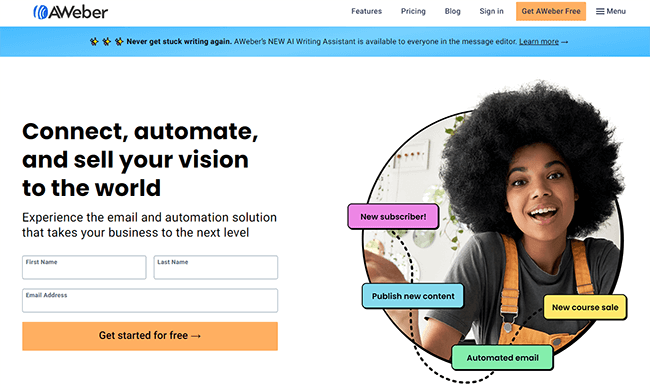
One of our favorite things about AWeber is its branded template tool. It can scan your website URL or Facebook page to automatically create a custom newsletter template with your brand logo, colors, etc.
And of course, it also comes with tons of other professionally-designed email templates for different types of campaigns.
The native Canva integration comes in useful when putting together images and visuals for your emails, as does the built-in stock image library, with thousands of high-quality images.
Once you’ve chosen a template, you can customize it in the drag-and-drop builder and schedule it for sending.
We also really like the Auto Newsletter feature—it can save you hours of work. You just connect AWeber to your blog, podcast, YouTube account, or Etsy page, and it’ll automatically send out newsletters to let your audience know about your latest content.
Aside from that, you also get tools to help you build landing pages, forms, and sales pages, plus the ability to create web push notifications, an AI writing assistant, and lots of other neat stuff.
Key features
- Drag and drop builder
- Pre-built autoresponders
- Email templates
- Stock images
- AI writing assistant
- Sign up forms
- Landing pages
- Auto Newsletter
- Dynamic content
- Segment subscribers
- A/B testing
- Analytics
Pros
- Easy to use
- Cutting-edge features
- Good value
- Extensive integrations
Cons
- Dated UI
- Unsubscribed contacts count toward plan limits
Pricing
Free plan is available. Paid plans start from $14.99/month, discounts are available with annual billing
Read our AWeber review.
#7 – GetResponse
GetResponse is a popular email marketing platform that’s easy to use and affordable. It has some neat AI-powered features and offers unlimited monthly emails on all plans.
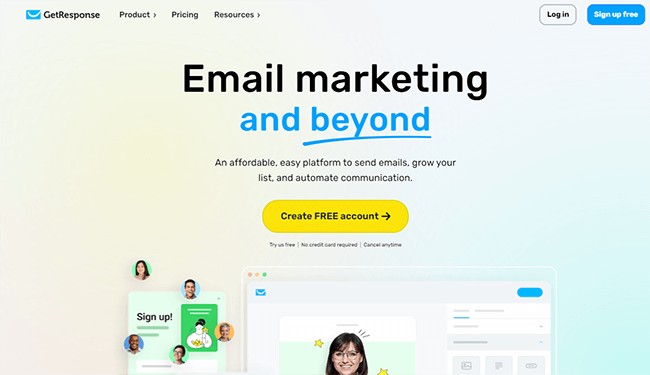
GetResponse has everything you need to collect contacts, nurture subscribers, and engage with your audience.
You can start by using it to create sign-up forms, pop-ups, and landing pages to grow your list.
Then, you can build newsletters and set up autoresponders to engage with your contacts. Plus, convert website visitors with web push notifications and live chat interactions.
AI-powered insights make it easy to promote the right products to the right customers, at the right time through your emails. And there are lots of ecommerce-friendly features like product recommendation emails, abandoned cart emails, and promo codes.
Key features
- Email marketing
- Autoresponders
- AI email generator
- Landing pages
- Website builder
- Automation
- SMS
- Web push notifications
- Live chat
- Conversion funnels
- Ecommerce
- Popups & forms
- Paid ads
- Webinars
- AI recommendations
Pros
- Easy to use
- Affordable
- Generative AI
- Customizable dashboard
- Excellent deliverability
Cons
- Some important features are only available in higher-tier plans
- Overkill if you just want to send email newsletters
Pricing
Free plan available. Plans start from $19/month, get 18% off when you pay yearly, or 30% off when you sign up for a 24-month plan. Get started with a 30-day free trial.
Read our GetResponse review.
#8 – Omnisend
Omnisend is an email and SMS marketing platform built for e-commerce businesses.
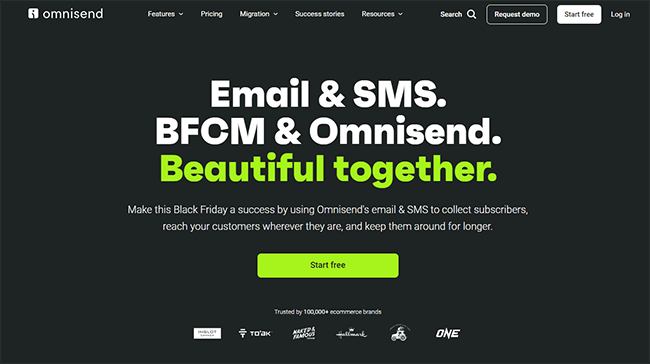
Omnisend has all the same features as most of the other tools we’ve looked at so far, with everything you need to build your list and send campaigns.
But what makes it special is that it comes loaded with features that make it perfect for online stores.
For example, there are lots of pre-built automations that drive ecommerce sales, like post-purchase campaigns, abandoned cart reminders, etc.
You can create unlimited audience segments for highly-targeted campaigns, and group audiences based on their shopping behavior.
Aside from email, you can also use Omnisend to launch integrated SMS campaigns and deliver web push notifications.
And of course, it also connects to all your favorite ecommerce platforms and tools, including Shopify, WooCommerce, and BigCommerce.
Key features
- Email builder
- SMS/MMS
- Web push notifications
- Custom audiences
- Email automation
- SMS automation
- Pre-built ecommerce workflows
- Custom workflows
- Conditional content blocks
- A/B split testing
- Segmentation
- Live view
- Web tracking
- Forms
- Popups
- Landing pages
- Reports
Pros
- Best for ecommerce businesses
- Great templates
- Extensive integrations
- Good free plan
Cons
- While templates are great, I’d like to see more added to the platform
Pricing
Free plan is available. Paid plans start from $16/month.
Read our Omnisend review.
#9 – Mailchimp
Mailchimp is one of the most popular email marketing and automation platforms on the market. It offers a pretty good free plan and a solid feature set.
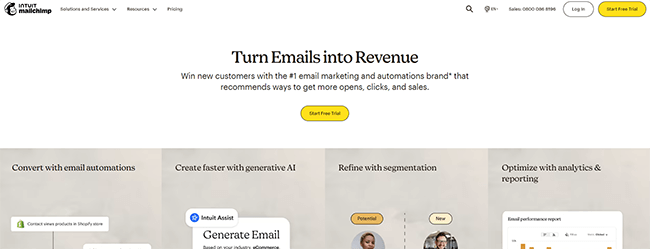
One of Mailchimp’s biggest strengths is its content creation toolkit. There are lots of features to help you craft compelling email newsletters in less time, including generative AI that can instantly create unique copy, plus lots of great email templates, and a creative assistant that you can use to generate beautiful designs.
You can use the A/B testing tool to test and optimize your emails. Other optimization features include Smart Recommendations (personalized insights), a Subject Line Helper (which helps you write compelling headlines), Send Time Optimization (so you know the best time to send emails to maximize opens and clicks), and a Content Optimizer.
You can automatically personalize emails with dynamic content, and use behavioral targeting to send targeted messages to different audience segments.
There’s also a Customer Journey Builder, which you can use to create automated campaigns. Plus, you also get access to a landing page builder, campaign manager, audience management tools, and even social media marketing tools.
Despite its rich feature set, MailChimp is very affordable. There’s a free plan that’s good for up to 1,000 monthly email sends, and a selection of paid plans to suit every budget.
Key features
- Email marketing
- Audience management
- Email templates
- Reporting & analytics
- AI tools
- Optimization tools
- Role-based access
- Automated Customer Journeys
- Send time optimization
- Predictive segmentation
- Dynamic content
Pros
- Great content creation tools
- Good optimization tools
- Rich feature set
- Affordable
- Easy to use
Cons
- Support could be better
- Email deliverability isn’t too good
- Popular platform for spammers (they could solve this by properly vetting new customer accounts)
Pricing
Free plan available. Paid plans start from $13/month, and your first month is free.
#10 – Substack
Last but not least, we have Substack—a super-popular subscription network, and a great choice for users who want a free email newsletter tool.
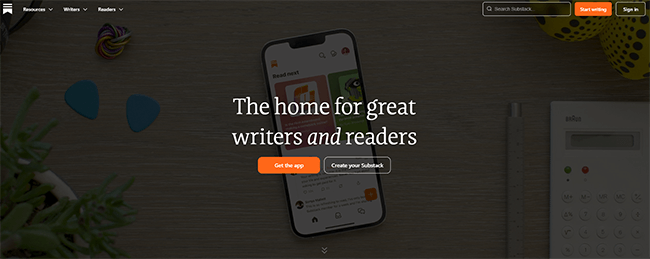
Substack is unlike all the other tools we’ve looked at so far. It’s not an email marketing platform. Rather, it’s somewhere between a newsletter platform and a social network. And it’s totally free.
It works like this. Writers and creators can sign up and publish content to their Substack freely (as blog posts and email newsletters). There are no monthly subscription costs and no ads.
However, if you choose to turn on paid subscriptions so that readers can support your work, Substack keeps a 10% cut of your revenues.
So for example, if you charge $10/month to subscribers, you’ll take home $9/month, and Substack takes a dollar.
You own everything you publish on Substack, as well as your subscription lists. So if you decide to migrate to a different platform, you can export everything and move over any time—no strings attached.
Aside from the fact that it’s free, what’s really cool about Substack is it has its own built-in audience—-40% of new subscriptions actually come from within Substack’s network.
So publishing content to your Substack gets it in front of thousands of potential readers and can help you grow your audience fast.
In total, over 35 million readers are subscribed to Substack feeds, and that includes 2 million paid subscriptions. All you need is a few hundred paid subscriptions to earn a full-time income.
Key features
- Newsletters
- Blog
- Payment system
- Subscriptions
- Mobile app
- Podcasts
- Videos
- Community (threads, comments, etc.)
- Reader network
Pros
- Helps you grow your audience
- No monthly subscription costs
- Great for paid newsletters
Cons
- Takes a cut of your earnings
- Lacks some advanced email marketing features
Pricing
Substack is completely free to use. There are no monthly subscription costs, but if you turn on paid subscriptions, Substack keeps 10% of your revenues.
Final thoughts
That concludes our roundup of the best email newsletter software.
All that’s left to do now is pick your favorite and sign up. But which should you choose?
If you’re still not sure, here’s what we’d suggest:
- Choose MailerLite if you just want the overall best newsletter platform. It gets top marks across the board with industry-leading deliverability, a rich set of features, an easy-to-use interface, and affordable plans.
- Try Moosend if you want the easiest-to-use newsletter software and email marketing service. It’s super beginner-friendly and very affordable.
- Go with Brevo if you’re a low-volume sender. It comes with unlimited subscribers on all plans, so it’s good value if you have a larger list but don’t send too many emails every month.
If none of the platforms on this list are a good fit for your needs, you can explore more options in our roundup of the best email marketing services.
Want to learn more about email marketing? Check out these posts.
- What Is Email Marketing? And Why Does It Matter?
- 13 Benefits Of Email Marketing You Need To Know
- 40+ Email Marketing Statistics And Trends
Good luck!
Disclosure: If you buy through links on our site, we may make a commission. This helps to support the running of Startup Bonsai.
